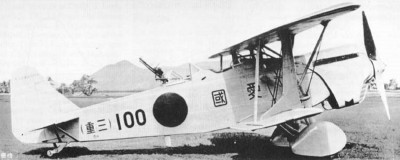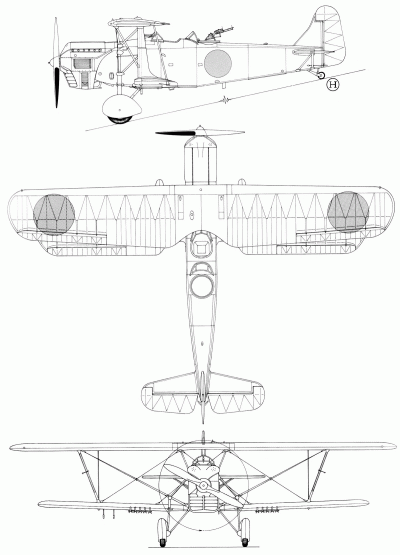| Název: Name: | Kawasaki Ki-3 | Kawasaki Ki-3 |
| Originální název: Original Name: | 川崎 九三式単軽爆撃機 [キ-3] | |
| Kategorie: Category: | bombardovací letoun | bomber aeroplane |
| Výrobce: Producer: | DD.04.1933-DD.03.1935 Kawasaki Shipyard, Ltd., Kakamigahara DD.MM.193R-DD.MM.193R Ishikawajima Airplane Manufacturing Co., Ltd., Tachikawa | |
| Období výroby: Production Period: | DD.01.1934-DD.03.1935 | |
| Vyrobeno kusů: Number of Produced: | 3 prototypy + 240 (200 Kawasaki a 40 Tachikawa) | |
| První vzlet: Maiden Flight: | DD.05.1933 | |
| Osádka: Crew: | 2 | |
| Základní charakteristika: Basic Characteristics: | ||
| Vzlet a přistání: Take-off and Landing: | CTOL - konvenční vzlet a přistání | CTOL - conventional take-off and landing |
| Uspořádání křídla: Arrangement of Wing: | dvouplošník | biplane |
| Uspořádání letounu: Aircraft Concept: | klasické | conventional |
| Podvozek: Undercarriage: | pevný | fixed |
| Přistávací zařízení: Landing Gear: | kola | wheels |
| Technické údaje: Technical Data: | ||
| Hmotnost prázdného letounu: Empty Weight: | 1650 kg | 3638 lb |
| Vzletová hmotnost: Take-off Weight: | 3097 kg | 6828 lb |
| Maximální vzletová hmotnost: Maximum Take-off Weight: | ? kg | ? lb |
| Rozpětí: Wingspan: | 13,000 m | 42ft 7,8in |
| Délka: Length: | 10,000 m | 32ft 9,7in |
| Výška: Height: | 3,000 m | 9ft 10in |
| Plocha křídla: Wing Area: | 38,00 m2 | 409.03 ft2 |
| Plošné zatížení: Wing Loading: | 81,58 kg/m2 | 16.71 lb/ft2 |
| Pohon: Propulsion: | ||
| Kategorie: Category: | pístový | piston |
| Počet motorů: Number of Engines: | 1 | |
| Typ: Type: | Kawasaki - BMW IX (Ha-9) kapalinou chlazený dvanáctiválec s válci do V o výkonu 588 kW (800 k). Vrtule dvoulistá dřevěná s pevným úhlem náběhu. | Kawasaki - BMW IX (Ha-9) twelve-cylinder liquid-cooled supercharged Vee engine rated at 789 hp, driving a wooden two-bladed fixed-pitch propeller |
| Objem palivových nádrží: Fuel Tank Capacity: | ? | ? |
| Výkony: Performance: | ||
| Maximální rychlost: Maximum Speed: | 259 km/h v 3000 m | 160.9 mph in 9843 ft |
| Cestovní rychlost: Cruise Speed: | 220 km/h v 2200 m | 136.7 mph in 7218 ft |
| Rychlost stoupání: Climb Rate: | ? m/s | ? ft/min |
| Čas výstupu na výšku: Time to Climb to: | 12,0 min do 3000 m | 12,0 min to 9843 ft |
| Operační dostup: Service Ceiling: | 7000 m | 22966 ft |
| Dolet: Range: | 900 km | 559.2 mi |
| Maximální dolet: Maximum Range: | ? km | ? mi |
| Výzbroj: Armament: | 1x pevný kulomet Type 89 ráže 7,69 mm 1-2x pohyblivý kulomet Type 89 ráže 7,69 mm pro obranu zadní části letadla max. pumový náklad 500 kg | One fixed forward-firing 0.303 Type 89 inch machine gun was mounted in the nose, synchronized with the propeller, and one or two flexible 0.303 inch Type 89 machine gun was mounted dorsally cocpit. Bomb load: Up to 1,100 lb. |
| Uživatelské státy: User States: | | |
| Poznámka: Note: | 九三式単軽爆撃機 - Kjusan-šiki tankei bakugekiki - Armádní jednomotorový lehký bymbardér typ 93-1 | 九三式単軽爆撃機 - Kyūsan-shiki tankei bakugekiki - Army Type 93-1 Single-engine Light Bomber The prototype KDA-6 was designed by the German engineer Dr. Richard Vogt, who was working in Japan at the time. Takeo Doi the future chief designer for Kawasaki, worked as Vogt's assistant on the project. The Kawasaki Ki-3 It was the last biplane light bomber design built by Kawasaki Kōkūki Kōgyō Kabushiki Kaisha for the Imperial Japanese Army in the 1930s. The type served in Korea and in Manchuria, before playing a major part in the early fighting in China. |
| Zdroje: Sources: | René J. Francillon Ph.D., Japanese Aircraft of the Pacific War, Naval Institute Press, Annapolis Maryland, Reprinted 1990, ISBN-0-87021-313-X Robert C. Mikesh a Shorzoe Abe, Japanese Aircraft 1910-1941 US Naval Institute Press, rok 1990, ISBN:10-1557505632 www.aviastar.org archiv autora | |
Kawasaki Ki 3
Kawasaki Ki-3 / 川崎 キ3・九三式单发轻爆击机
Kawasaki Ki-3
九三式单发轻爆击机 / Kyūsan-shiki tankei bakugekiki / Army light bomber, Type 93
Brief history:
Rikugun Koku Hombu from the beginning of the thirties sought to modernize and thereby improve the efficiency of your air force bomber. The armament included heavy bomber The Mitsubishi Ki-1, medium bomber the Mitsubishi Ki-2, logically, being asked also a light bomber, which had to fulfil as far as possible tactical tasks.
The development was entrusted to the factory Kawasaki Kokuki Kabushiki Kaisha, there was already, on its own initiative developed the project of the German designer dr. Richard Vogta, which assisted already at that time an experienced engineer Takeo Doi.
The prototype with the designation of the KDA-6, fully based on their previous structures, which arose at the turn of the twenties and thirties. The main characters were robusnost and as with all single-engine constructions of the Kawasaki was used inline engine, which propagátorm and a supporter of the factory Kawasaki was.
After tests in 1933 was a bomber accepted into the arms as "light army bomber type 93" and in the newly established system of labelling Kitai got the designations Ki-3.
Production of the Ki-3 are sold all from the January, 1934, and lasted less than fifteen months and already one year after the completion of the production, therefore, in the year of 1936 is considered to be outdated, it served, however, in the chinese battlefield in the first line until 1938.
The bomber showed a fairly decent flight characteristics, but undermined it rather the fault of the engine, namely, his compressor, it was also the main cause why this Type of 93-1 nedoznal great popularity, both in flying and ground personnel. In the service was replaced by the modern types of Mitsubishi Ki-30 Ann Type 97 and Kawasaki Ki-32 Mary Type 98.
sources:
Robert C. Mikesh, Japanese Aircraft 1910-1941 US Naval Institute Press, 1990, ISBN:10-1557505632
www.aviastar.org
http://www.hikotai.net/datasheets/ki3.htm
the archive of the author.
九三式单发轻爆击机 / Kyūsan-shiki tankei bakugekiki / Army light bomber, Type 93
Brief history:
Rikugun Koku Hombu from the beginning of the thirties sought to modernize and thereby improve the efficiency of your air force bomber. The armament included heavy bomber The Mitsubishi Ki-1, medium bomber the Mitsubishi Ki-2, logically, being asked also a light bomber, which had to fulfil as far as possible tactical tasks.
The development was entrusted to the factory Kawasaki Kokuki Kabushiki Kaisha, there was already, on its own initiative developed the project of the German designer dr. Richard Vogta, which assisted already at that time an experienced engineer Takeo Doi.
The prototype with the designation of the KDA-6, fully based on their previous structures, which arose at the turn of the twenties and thirties. The main characters were robusnost and as with all single-engine constructions of the Kawasaki was used inline engine, which propagátorm and a supporter of the factory Kawasaki was.
After tests in 1933 was a bomber accepted into the arms as "light army bomber type 93" and in the newly established system of labelling Kitai got the designations Ki-3.
Production of the Ki-3 are sold all from the January, 1934, and lasted less than fifteen months and already one year after the completion of the production, therefore, in the year of 1936 is considered to be outdated, it served, however, in the chinese battlefield in the first line until 1938.
The bomber showed a fairly decent flight characteristics, but undermined it rather the fault of the engine, namely, his compressor, it was also the main cause why this Type of 93-1 nedoznal great popularity, both in flying and ground personnel. In the service was replaced by the modern types of Mitsubishi Ki-30 Ann Type 97 and Kawasaki Ki-32 Mary Type 98.
sources:
Robert C. Mikesh, Japanese Aircraft 1910-1941 US Naval Institute Press, 1990, ISBN:10-1557505632
www.aviastar.org
http://www.hikotai.net/datasheets/ki3.htm
the archive of the author.
Reklama
Photos Of The Kawasaki Ki-3
resources Used:
Robert C Mikesh and Shorzoe Abe:“Japanese Aircraft 1910-1941“; Putnam Aeronautical Books, 1990; ISBN: 1557505632 .
resources Used:
Robert C Mikesh and Shorzoe Abe:“Japanese Aircraft 1910-1941“; Putnam Aeronautical Books, 1990; ISBN: 1557505632 .
| Period | - |
| Producer | - |
| Type | - |
| Camouflage | - |
| Country | - |
| Pilot | - |
| Production No. | - |
| Serial No. / Evidence No. | - |
| Tactical Marking / Imatriculation | - |
| Name | - |
| Unit | - |
| Base | - |
| Date (DD.MM.RRRR) | DD.MM.RRRR |
| Author | - |
| Print size / 300 DPI | - |
| Published with authors permit | - |
| Author Website | - |
| Period | - |
| Producer | - |
| Type | - |
| Camouflage | - |
| Country | - |
| Pilot | - |
| Production No. | - |
| Serial No. / Evidence No. | - |
| Tactical Marking / Imatriculation | - |
| Name | - |
| Unit | - |
| Base | - |
| Date (DD.MM.RRRR) | DD.MM.RRRR |
| Author | - |
| Print size / 300 DPI | - |
| Published with authors permit | - |
| Author Website | - |
http://www.airwar.ru/enc/bww1/ki3.html
.| Period | - |
| Producer | - |
| Type | Kawasaki Ki 3 |
| Camouflage | - |
| Country | - |
| Pilot | - |
| Production No. | - |
| Serial No. / Evidence No. | - |
| Tactical Marking / Imatriculation | - |
| Name | - |
| Unit | - |
| Base | - |
| Date (DD.MM.RRRR) | DD.MM.RRRR |
| Author | - |
| Print size / 300 DPI | - |
| Published with authors permit | - |
| Author Website | - |
Join us
We believe that there are people with different interests and experiences who could contribute their knowledge and ideas. If you love military history and have experience in historical research, writing articles, editing text, moderating, creating images, graphics or videos, or simply have a desire to contribute to our unique system, you can join us and help us create content that will be interesting and beneficial to other readers.
Find out more

